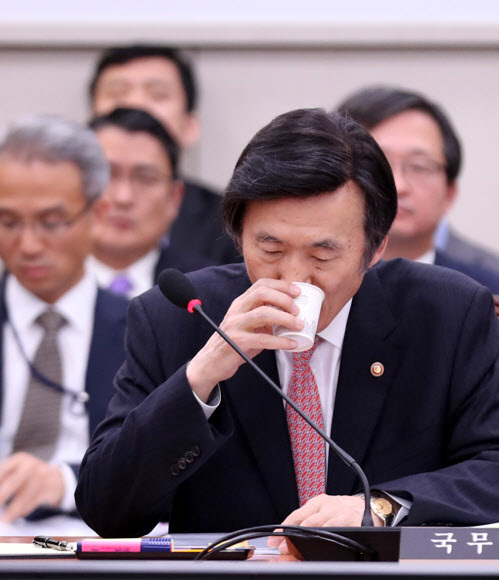 |
|
Former South Korean Minister of Foreign Affairs Yun Byung-se
|
Ministry justified actions by claiming torrent of lawsuits would burden the judiciary
Around the time that the Supreme Court under former chief justice Yang Seung-tae and the Blue House under former president Park Geun-hye were making a deal about sending judges to Korean embassies overseas and handling a lawsuit that Korean victims of forced labor were filing against Japanese companies guilty of war crimes, the South Korean Ministry of Foreign Affairs apparently tried to persuade the judiciary to delay the lawsuit on the grounds that a ruling that found Japanese companies responsible for the forced labor would unleash a torrent of lawsuits by 200,000 people. On Aug. 20, Hankyoreh reporters learned that the Foreign Ministry estimated that “more than 200,000 potential plaintiffs could file a lawsuit as victims of forced labor” in a document from Nov. 2013 intended to make its case to the country’s judiciary. The document also urged the judiciary to delay the trial on the grounds that a Supreme Court decision confirming Japanese companies’ responsibility “is likely to lead to a flood of domestic lawsuits that could place a burden on the judiciary.” Deferring to a Supreme Court ruling in May 2012, the Seoul High Court and the Busan High Court had ruled in 2013 that Mitsubishi and Nippon Steel had to compensate nine plaintiffs, paying each plaintiff between 80 and 100 million won (US$71,580-89,475) in damages. If the Supreme Court affirmed these rulings, the Foreign Ministry document suggested, there would be a rush of copycat lawsuits that would create a heavy workload for judges. More specifically, the Foreign Ministry urged the Supreme Court to delay its final decision in the cases until “after 2015.” Some legal analysts had been advising potential plaintiffs to file their lawsuits by May 23, 2015, calculated as being three years after the Supreme Court’s first ruling that held Japanese companies responsible on May 24, 2012. These analysts were relying on a rule in civil law that requires lawsuits to be filed within three years of the date when the victim learns of loss resulting from an illegal act or the person responsible for that loss. In short, the Foreign Ministry had meticulously worked out the timeline in order to prevent victims who found out about the ruling later from filing their own lawsuits, even if the Supreme Court did find for the plaintiffs. This suggests that the Ministry was uninterested in trying to resolve historical issues or guaranteeing the people’s civil rights. The Foreign Ministry’s document was drafted shortly before a “four-party meeting” on Dec. 1, 2013, between then Blue House Chief of Staff Kim Ki-choon; Hon. Cha Han-seong, Supreme Court justice and head of the National Court Administration; Foreign Minister Yun Byung-se and Justice Minister Hwang Kyo-ahn. This was also not long after Yun met with Lim Jong-heon, former deputy director of the National Court Administration, on Oct. 2013 and was informed of the likely outcome of the forced labor lawsuit and given the request for judges to be sent overseas by Ju Cheol-gi, Blue House Senior Secretary for Foreign Policy and Security. It was during this meeting that Yun reportedly communicated the Foreign Ministry’s argument to the judiciary. After the judiciary and the National Court Administration conspired to delay the lawsuit about the victims of forced labor, the case remained in limbo for five years until it was finally referred to the full panel of the Supreme Court last month. Less than 1,000 of the 200,000 victims estimated by the Foreign Ministry have filed lawsuits since the Supreme Court’s ruling in 2012, and some of them reportedly considered waiting until the Supreme Court had made its final ruling before filing. In Mar. 2015, lawmakers with the New Politics Alliance for Democracy (currently called the Democratic Party) submitted a special bill to prevent the timeframe for filing a lawsuit about forced labor from expiring, but their efforts were ultimately thwarted by opposition from the ruling party at the time. By Hyun So-eun, staff reporter Please direct comments or questions to [english@hani.co.kr]






